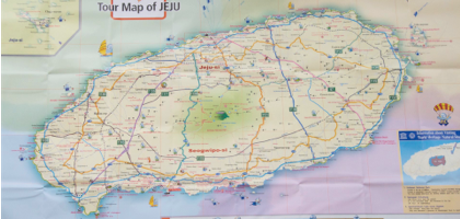
03/09/2010
W ostatni weekend, jako ostatnia pozycję zwiedzana, wybraliśmy się na koreańską wyspę Jeju, na południu Korei. W sumie spędziliśmy tam 4 dni i było to coś w rodzaju wakacji, ponieważ w tym roku jeszcze nigdzie na wakacjach nie byliśmy (dla Piotrka pobyt w Bucheon nie liczy się jako wakacje ;)
Lecieliśmy z lotniska Seul Gimpo (20 min taksówką od hotelu), tymi samymi liniami którymi przylecieliśmy do Korei czyli Korean Air. Loty na Jeju latają bardzo często, co 15-20 minut z Korean Air, plus do tego dochodzą inne linie lotnicze, więc nawet częściej. Lot trwał około godziny a po wylądowaniu wzięliśmy taksówkę do hotelu, który znajduje się pół godziny jazdy od lotniska na wschód.
Last weekend, as a final place to see in Korea, we decided to visit Jeju island, in the south of Korea. We spent there 4 days and it was a sort of a holiday for us as we haven’t been anywhere yet this year (the stay in Bucheon doesn’t count as holidays for Piotr ;)
We went by Korean Air from Seoul Gimpo airport (about 20 min drive from our hotel). Flight to Jeju are very frequent, every 15-20 min with Korean Air, plus there are also other airlines so the flights are even more often. Our flight was about one hour and after landing we took a taxi to the hotel, which was about half an hour drive from the airport, towards east.
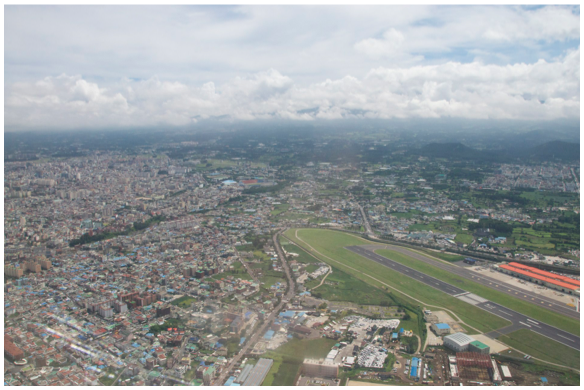
Wyspa Jeju jest popularnym wakacyjnym miejscem dla Koreańczyków, z plażami i klimatem trochę innym niż reszta kraju (ja nie zauważyłam różnicy ;)
Jeju powstała całkowicie na skutek wybuchu wulkanu około 2 milion lat temu. Znajduje się na Morzu Wschodnio-Chińśkim, jest wyspą wulkaniczną, zdominowaną przez Halla-san (Góra Halla) - wulkan o wysokości 1950m i jednocześnie najwyższy szczyt Korei Południowej. Góra znajduje się na środku wyspy i jest widoczna prawie z każdego krańca, ale najczęściej tonie w chmurach. Tereny bezpośrednio dookoła Góry Halla to park narodowy i można wybrać się również na zdobycie szczytu którym jest krater o średnicy 400m. Wyspa ma 73km z zachodu na wschód, i 31 km z północy na południe. Klimat wyspy to wilgotny podzwrotnikowy, cieplejszy niż reszta Korei, i gdzie wyraźnie można rozróżnić 4 pory roku. Zimy są zimne i suche podczas gdy lato jest gorące, wilgotne ale czasem deszczowe.
Jeju island is a sort of a holiday spot for Koreans, with beaches and a climate a bit different than the rest of the country (I didn’t notice any difference ;)
Jeju was created entirely from volcanic eruptions about 2 million years ago. This volcanic island is situated on East China Sea, and is dominated by Halla-san (Mount Halla) - a volcano 1950m high and the highest mountain in South Korea at the same time. Halla is situated in the middle of the island and is visible from almost every end of the island, but most of the time it is deep in the clouds. The area around the Halla Mountain is a national park so you can do a lot of hiking and climb to the top, where you will find a huge crater with a 400m (1300 ft) in diameter. The island is 73km from east to west, and 31 km from north to south. The climate is humid subtropical, warmer than the rest of Korea, where 4 seasons can be distinguished. Winters are cold and dry, while summers are hot, humid but often rainy.
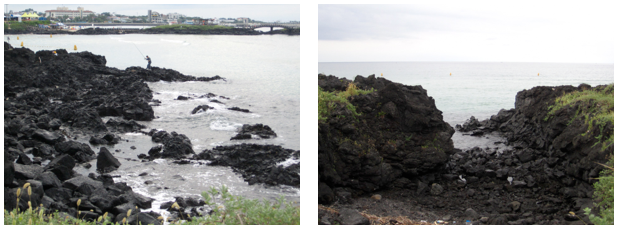
Wyspa jest odizolowana od resztu kraju dlatego też wyróżnia się swoją indywidualnością. Symbolem Jeju jest wszechobecny i wszędzie widoczny na wyspie kamienny dziadek (dol hareubang 돌 하르방) z wielkimi oczami i wielkim nosem.
The island is a bit isolated from the rest of the country so it has its own personality. The symbol of Jeju is an obiquitous stone grandfather (dol hareubang 돌 하르방) with big eyes and big nose.

Na wyspie, oprócz plaż (których tak naprawdę nie jest zbyt wiele), jest mnóstwo atrakcji i dużo do zobaczenia - parki, ogrody botaniczne, wodospady, kratery, jaskinie, ogród drzew Bonsai, tradycyjne wioski, a z ciekawostek - Muzeum Misów Pluszowych, Muzeum Zielonej Herbaty, Muzeum Czekolady, a nawet Muzeum Zdrowia i Sexu, ogród drzew Bonsai. Dookoła Jeju jest kilka mniejszych wysepek na które też organizowane są wycieczki. Napewno nie można się tam nudzić.
Wypożyczenie samochodu na kilka dni jest chyba najlepszym rozwiązaniem aby zobaczyć różne zakątki wyspy. Całość można spokojnie objechać samochdem w kilka godzin. Czytałam że można też wynająć taksówkę na cały dzień ale mało który taksówkarz mówi po angielsku. Dobrym pomysłem byłoby nawet co noc spać w innym hotelu i wtedy maksymalnie wykorzystać swój pobyt.
Besides a few beaches on the island, the island offers a lot of attractions and a lot to see - parks, botanic gardens, waterfalls, craters, caves, Bonsai trees garden, traditional folk villages, and also a few museums such as Teddy Bear Museum, Green Tea Museum, Chocolate Museum, and also Health and Sex Museum. There are also a few islets around Jeju where trips are also possible. You will definitely have no time to get bored. Renting a car for a few days is a good idea to see most of the island. You can drive around the island in just few hours. I also read that you can hire a taxi for a whole day but not a lot of drivers actually speak English. The taxi for a whole day would be comparable in price to renting a car. I think it would also be a good idea to spend every night in different hotel in different parts of the island, to maximise Jeju experience :)
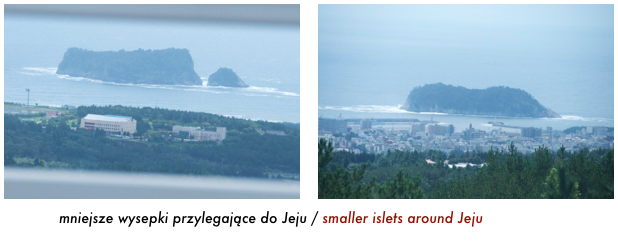 Hotel w którym się zatrzymaliśmy był tak blisko plaży jak tylko się dało, bez wydawania fortuny - Ocean Grand Hotel. Mieliśmy pokój na 3 piętrze (w Korei parter to zawsze piętro 1, więc 3 piętro w Korei to po europejsku 2 piętro). Pokój miał podwójne łóżka i pojedyncze ale Maya spała na dwóch krzesłąch połączonych ze sobą, bo tak było bezpieczniej. Internet mieliśmy wliczony w cenę i bardzo szybki, więc Piotrek był zadowolony ;) Mieliśmy też balkon i przepiękny widok na morze i plażę Hamdeok i wzgórze Seoubong. Bardzo ciekawie było widzieć morze i plażę w ciągu dnia, szczególnie jak świeciło słońce - wtedy było widać prawdziwe lazurowe kolory morza. Za to rano i wieczorem podczas odpływu - kompletnie zmieniony widok, mniej wody a więcej piasku więc jeszcze ciekawiej.
Hotel w którym się zatrzymaliśmy był tak blisko plaży jak tylko się dało, bez wydawania fortuny - Ocean Grand Hotel. Mieliśmy pokój na 3 piętrze (w Korei parter to zawsze piętro 1, więc 3 piętro w Korei to po europejsku 2 piętro). Pokój miał podwójne łóżka i pojedyncze ale Maya spała na dwóch krzesłąch połączonych ze sobą, bo tak było bezpieczniej. Internet mieliśmy wliczony w cenę i bardzo szybki, więc Piotrek był zadowolony ;) Mieliśmy też balkon i przepiękny widok na morze i plażę Hamdeok i wzgórze Seoubong. Bardzo ciekawie było widzieć morze i plażę w ciągu dnia, szczególnie jak świeciło słońce - wtedy było widać prawdziwe lazurowe kolory morza. Za to rano i wieczorem podczas odpływu - kompletnie zmieniony widok, mniej wody a więcej piasku więc jeszcze ciekawiej.
The hotel we stayed at was as close to the beach as possible, without spending a fortune - Ocean Grand Hotel. We had a room with an ocean view on the 3rd floor (in Korea fround floor is always floor 1, so we were on floor 2 if we look at it in an European way). The room had one double, one single bed, but Maya slept on 2 chairs connected together as it was safest.
Internet connection was included in the price and unlimited in the room, and very fast so Piotr was happy ;) We had a balcony with gorgeous view of the Hamdeok Beach and Seoubong Peak. It was really interesting to see the sea and the beach during the day, especially in the sun, so that we could see the beautiful colours of the sea. In the morning and evening there was a low tide so the view was a bit different as the beach extended further to the sea, so it was even more interesting.
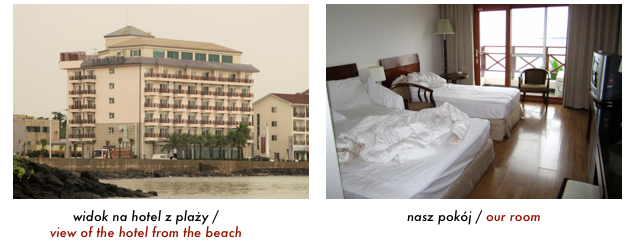
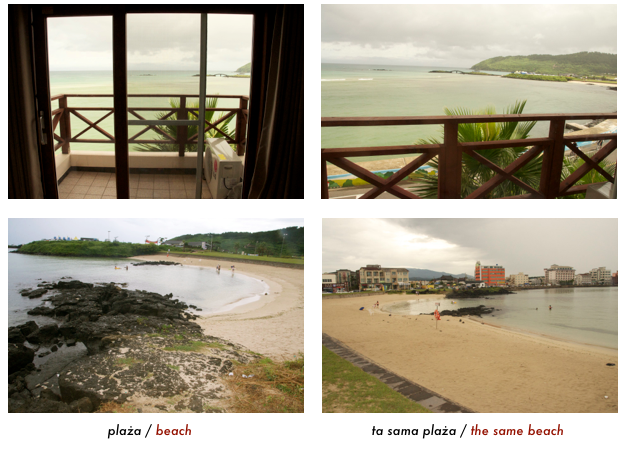
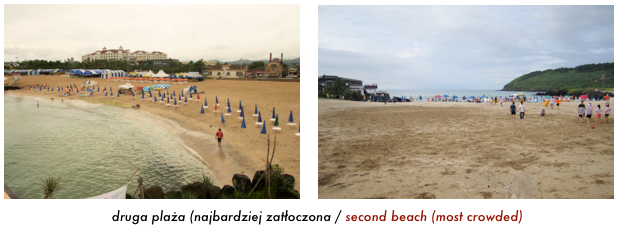

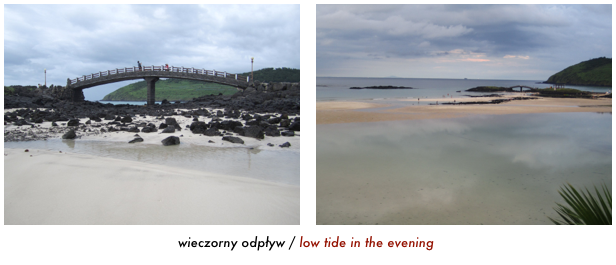
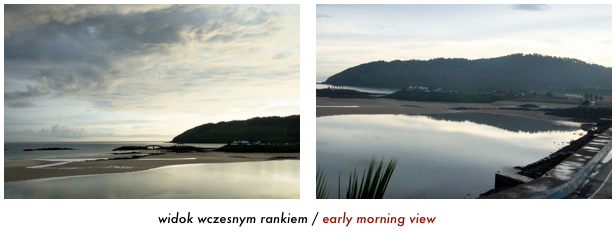
Wyspa jest bardzo ładna i przypomnała nam trochę karaibską Jamajkę a trochę Barbados. Dużo zieleni, otwatych przestrzeni i niezamieszkałych terenów, i niewiele bloków których tak dużo widzimy na codzien mieszkając w Bucheon. Celem naszego wypadu był relaks i odpoczynek więc nie zwiedzaliśmy zbytnio. Zresztą z małym dzieckiem i duszną, upalną pogodą, to trochę jest męczące dla obu stron. Wybraliśmy się jedynie na zwiedzenie Muzeum Misów Pluszowych, o czym napiszę w osobnym poście.
Poza tym nasz hotel i plaża były na północy wyspy, trochę bardziej spokojniejsza część, a najwięcej atrakcji jest na południu (Seogwipo), więc jakbyśmy się skupiali na zwiedzaniu to napewno wybralibyśmy hotel na południu.
The island is really beautiful and it reminded us a bit of carribean Jamaica and a bit of Barbados. There is a lot of open, green spaces, without buildings, and barely any apartment blocks we see in mainland Korea.
The aim of our visit to Jeju was just to relax and do nothing so we didn’t do any sightseeing. Beides with a small baby and a humid, hot weather, it can be a bit exhausting for both of us. We only chose to visit Teddy Bear Museum in the south of the island, but it will be in a separate entry.
Our hotel and the beach were in the north of the island, a bit quieter part of it, as the most attractions, musuems, etc are in the south (Seogwipo). If we were focusing on sightseeing more, we would definitely chose to stay in a hotel in the south.
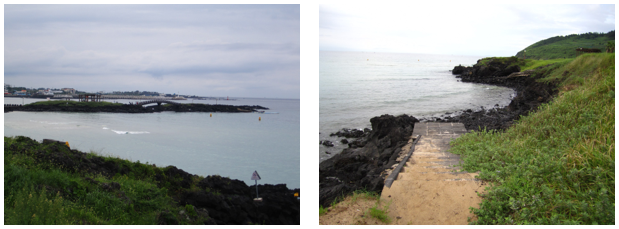
Pogoda była trochę w kratkę więc jak padało to siedzieliśmy w hotelu. Ale większość pobytu było w miarę pogodnie (padało głównie w nocy) więc korzystaliśmy i odwiedzaliśmy plażę. Na plaży jest wypożyczalnia wszelkiego wodnego sprzętu od kółek wodnych dla dzieci, kamizelek, po kajaki, rowery czy skutery. Każdy znajdzie coś dla siebie.
Nie przesiadywaliśmy za długo bo było dosyć duszno. Dla Mayki to pierwsza wizyta nad morzem i na plaży - miała bliskie spotkania z wodą morską i piaskiem plażowym po raz pierwszy w życiu :) Woda była trochę za zimna żeby się z nią kąpać więc głównie kończyło się na moczeniu nóg.
The weather was a mixture of rain and sun so when it rained, we usually stayed at the hotel. Lucky for us most of the rain was during the night, so we usually walked to the beach. There is water sports equipment available to rent such as kids swim rings, vests, or kayaks and jet ski. We didn’t s spend too much time on the beach because it was just too hot. For Maya it was her first time by the sea and on the beach - close encounters with sea water and beach sand for the first time :) The water was a bit too cold to give Maya a swim so we sticked to wetting our legs.
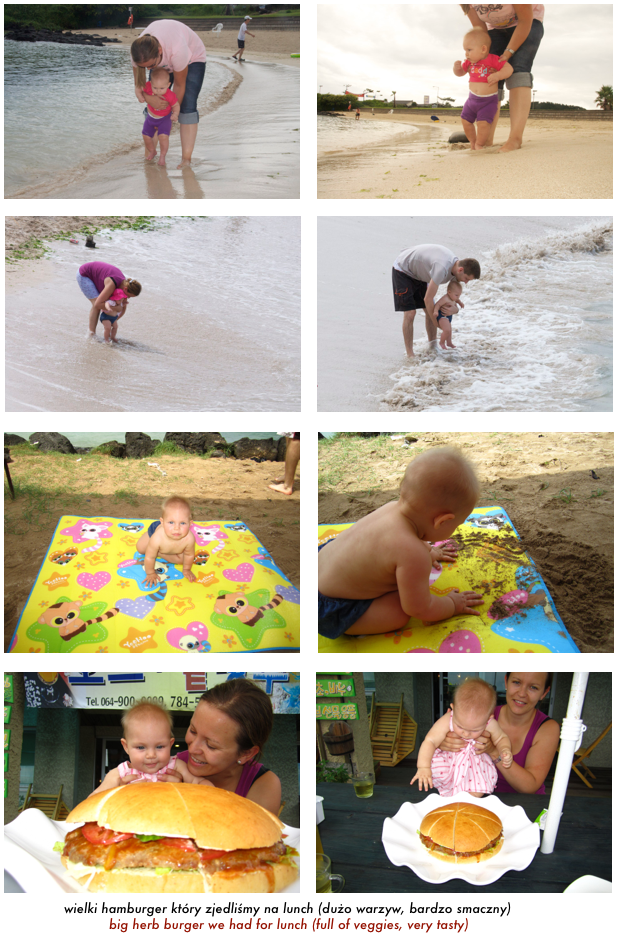
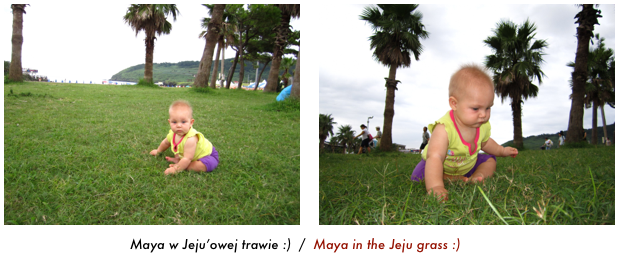
Najciekawiej było popołudniami kiedy był odpływ, wtedy można było chodzić po dnie morza ;) i dosyć daleko zapuszczać się w głąb, mocząc nogi zaledwie po kostki lub wcale.
The most interesting time of the day was late afternoon, with the low tide, so we could walk on the sea bed :) and go quite far, having our feet barely wet, or not at all.
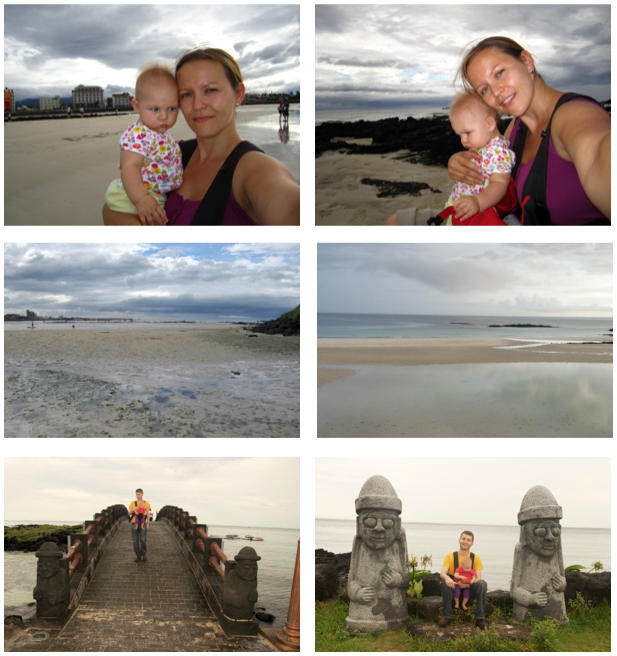
Weekend możemy jak najbardziej zaliczyć do udanych. Miła zmiana klimatu i hotelu ;)
We really enjoyed our stay in Jeju. It was a nice break from Bucheon ;)

